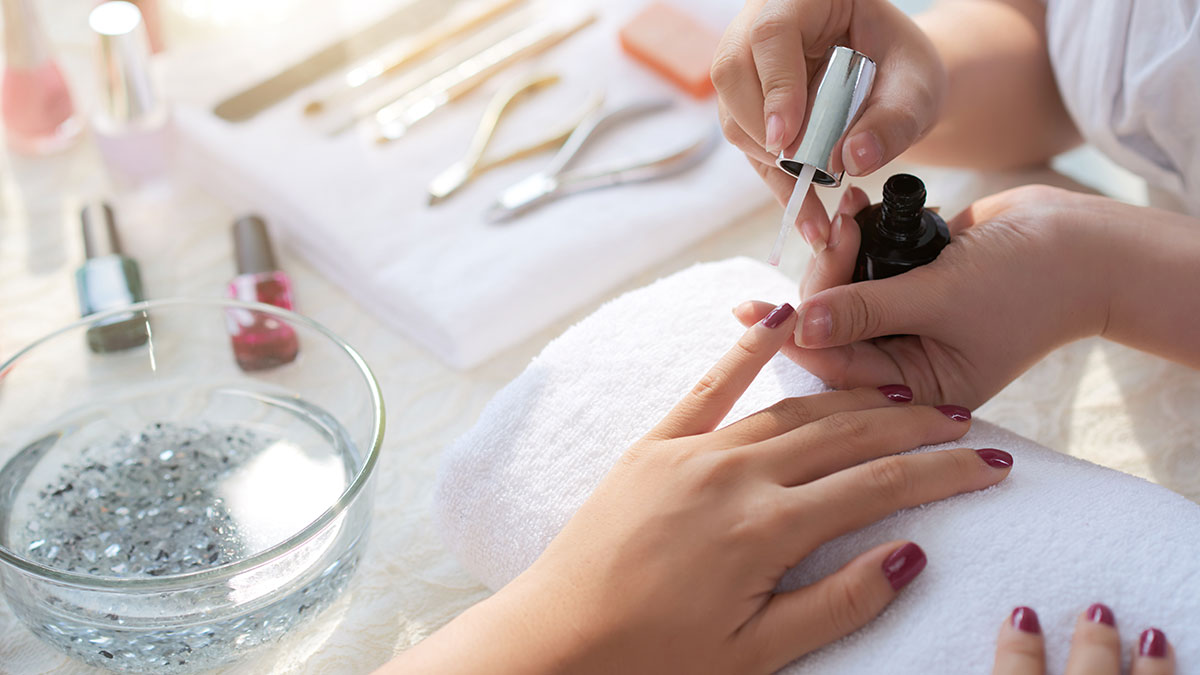Mastering Nail Polish Application: Tips for Long-Lasting and Professional Results

Refine your skills with professional-grade techniques designed for ambitious nail technician trainees.
Step 1: Preparation.
Create a swab with cotton and an orange wood stick. Soak the swab in 99.9% alcohol. Thoroughly wipe the surface of the nails to remove any oil or water.
Also, wipe the backside of the free edges of the nails. The key is to avoid touching the skin with the swab, as strong alcohol can cause dryness of the skin.
If there are any nail shavings remaining at the edge of the nail, remove them with the orange wood stick. If you can't remove them, use a sponge buffer to gently sand the nail edges. Don't forget to clean up the nails afterward.
Step2: Base Coat Application.
The base coat has the role of protecting natural nails and should be applied. First of all, I'd like to introduce how to handle the bottle and brush.
To apply any polish, hold the bottle with the base of the thumb, ring, and pinky fingers, leaving the other fingers free to control the customer's fingers.
After opening the lid, use the bottle neck to adjust the amount of liquid on the brush by rotating it.
Basically, apply polish to the edges and surfaces of the nails.
When applying to the edges, make the brush thinner to paint the narrow space and make sure to cover the whole free edge.
On the other hand, widen the brush as you press it against the bottle neck to cover a broader area. The size of the spread depends on the length and width of the nail.
To the Nail Edges.
First, apply the base coat at the nail edges. Basically, start applying any polish from the pinky finger on the right hand. Turn the customer's palm up for the right hand and apply the base coat to the edges, excluding the thumb. Pinch the sidewalls to pull the skin back, avoiding getting the liquid on the skin. After that, place the thumb on top and apply the base coat to the edge.
For the right hand, the procedure will be reversed.
To the Surfaces of Nails.
First, apply the base coat to the center of the nail plate. Position the brush about 1 - 2 mm in front of the proximal nail fold. Push the brush in while getting it as close as possible to the very proximal nail fold, then pull it forward. If polish seems not enough, put the brush back in the bottle and add more liquid immediately. Always pull the skin down to prevent the polish from getting on the skin. If the nails are not well cared for, the skin may not be easily pulled down.
Second, apply the base coat to the side of the nail plate. Draw a curve along the nail cuticle using the edge of the brush. Pay special attention to the corner between the cuticle and the sidewall of the nail, as it can be challenging to apply polish there. Pull the skin down as much as possible and handle the brush with care. After passing the corner, pull the brush forward to cover all edges of the side nail plates with polish.
Third, apply the base coat to the other side of the nail plate, following the same process as the second step. If you are unable to cover the entire nail plate, for example, with thumbnails, apply the base coat up to 5 times.
Other technique.
If you get polish on the skin, wrap a small piece of cotton around the edge of the orange wood stick, lightly dip it in polish remover, and remove the polish before it dries.
Step3: Coloring.

Coloring basically follows the same process as applying the base coat. The color polish is typically applied twice. The first and second coats have slight differences. The first coat should thinly cover the entire nail plate and create beautiful curves along the cuticle line. The second coat should even out any unevenness and be applied evenly, without the need to apply polish to the edges. The most challenging color isn’t red but matte pale pink.
There are three practices to improve applying color on the nails.
- First, practice adjusting the width of the brush and the amount of polish.
- Second, practice drawing curves with the brush using the nail polish again and again.
- Third, practice pulling the skin back while applying polish.
Near the proximal nail folds, apply the color slightly inside the area where the base coat was applied. The gap may be approximately 0.05 - 0.1 mm.
Don’t forget to wipe the bottle neck after use.
Step4: Top Coat Application.
The top coat helps maintain shine and reinforce the surfaces of the color polish. Applying the top coat also follows the same process as applying the base coat.
Near the proximal nail folds, apply the top coat slightly outside the area where the color polish was applied.The gap may be approximately 0.05 - 0.1 mm.
Step5: Cuticle Oil Application.
In the end, apply cuticle oil. While the polish on the nails dries, the skin at the tips of the nails also tends to dry out. Additionally, cuticle oil helps nail polish dry quickly. Apply a small amount of cuticle oil on the nail cuticle and gently spread it around the skin.
If the surfaces of the nails seem to be dry, gently apply some oil there as well. Never apply pressure when doing so.
- nail
- Polish